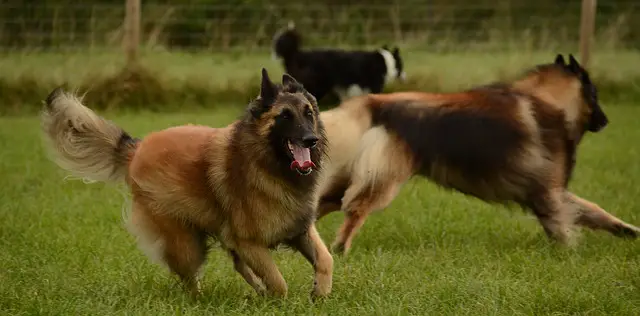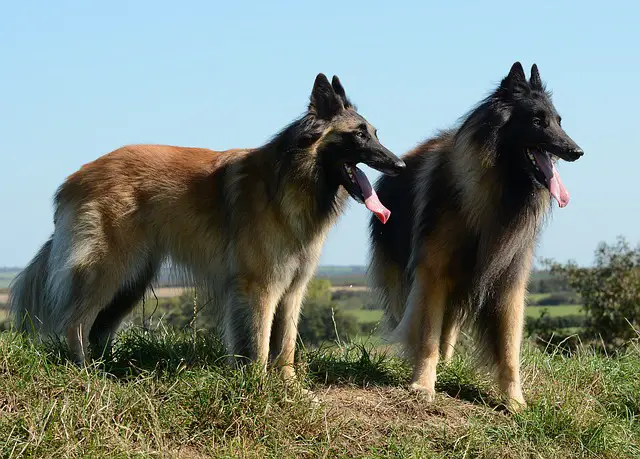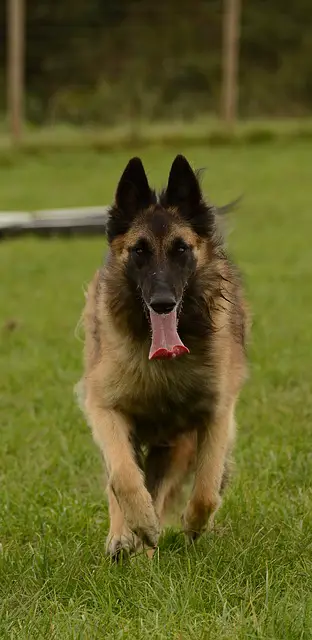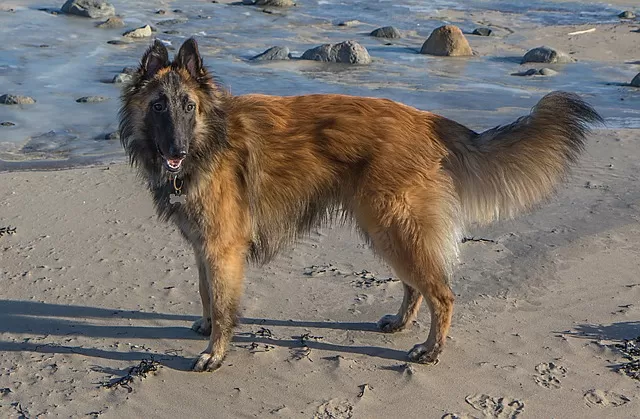The Belgian shepherd Tervuren is one among a wonderful array of herding breeds. You may have heard of the Belgian Tervuren, but are not as familiar with them as you are with other herding breeds such as the German shepherd, border collie, or Australian shepherd.
If you are looking for a breed of dog that definitely has a different appearance than every other dog on your block, this could be the breed for you.
If you are active and energetic, the Belgian Tervuren fits the bill for an excellent exercise buddy.
This breed also has the smarts to match up with their energy and is a snap to train. The Belgian Tervuren is a great breed to choose for a family dog or a single person.
In this post, I will give you some information and facts about the Belgian Tervuren.
I will include Belgian Tervuren temperament and breed characteristics as well.

For your dog’s vitamin supplement, food, toys, or other dogs product please visit the Health Extension website.
History of the Belgian shepherd Tervuren
The Belgian Tervuren originated in the 1800s in Tervuren, Belgium the home of its creator, M.F. Corbeil. At this time the Turveren was one of four different dogs all lumped into one category known as Belgian shepherds.
These original Tervurens came from a pair of dogs that were fawn in color, with tips tinged with black. Up until 1891, four dogs were known as Belgian shepherds, but in that year they became four different breeds.
The four are the Belgian Laekenois, the Groenendael (today known as the Belgian sheepdog), the Malinois, and the Tervuren.
The Belgian Tervuren was originally used as a herding dog, but as the years passed it was found that this breed possessed many other useful skills.
They were used as guards for police, helpers to the Red Cross, and messengers during World War I, also pulling wagons loaded with guns.
The Belgian Tervuren was introduced in the United States in 1953 but was again known as the Belgian shepherd, which included a different color variety.
In 1959, the American Kennel Club granted this dog would be a separate breed, the Belgian Tervuren. In some countries today, the Belgian Tervuren is still known as a different variety of Belgian shepherds.
Today, the Tervuren is still used for herding as well as working with the military and police, although not yet as popular as the German shepherd or the Belgian Malinois. They make excellent show dogs as well as great family pets and companions.
To check your shepherds’ health status or their DNA checks, please visit the Embark vet website for all the help you may need.

Belgian Tervuren Appearance
If you are unfamiliar with all of the different dog breeds there are, at first glance, you may think that the Belgian Tervuren is just a long-haired German shepherd. Taking a closer look, in some ways they are similar and in others the differences in appearance are evident.
This breed is considered a medium to large breed as is the German shepherd. A female Tervuren will weigh between 60lbs to 70lbs while a male can weigh from 65lbs to 75lbs. The female German shepherd can weigh from 49lbs to 71lbs and the male, 66lbs to 88lbs makes the German shepherd a slightly larger dog.
The Belgian Tervuren is a much more graceful and elegant dog than the German shepherd, in their looks and the way they carry themselves but at the same time are very athletic, possessing an abundance of stamina for running, hiking, and playing.
The Belgian Tervuren’s coat, which is double thick, has a dense short undercoat with an overcoat of straight long hair.
The German shepherds are doubled but shorter. As for the other Belgian breeds, the Malinois is short-haired, the Belgian sheepdog is long-haired but black in color and the Laekenois has wiry fur.
The Belgian Tervuren is a moderate shedder while oddly the German shepherd sheds more even though their hair is shorter.
Generally, the German shepherd is black and tan but the Tervuren can be fawn or mahogany with black-tipped fur and have other hues of cream and brindle mixed in. They also have a dark-tipped tail.
The Belgian Tervuren sports a long face with triangle-shaped ears, a black nose, and dark brown eyes. They also display a puffy fur collar around their neck which is more pronounced in males.

Belgian Tervuren Temperament and Characteristics
The Belgian Tervuren makes an excellent companion and pet for a small family of one or two or a larger family.
This breed is a friendly, active, and energetic dog and because of their intelligence and instinctual herding smarts, they are relatively easy to train. This breed’s characteristics are loyal, affectionate courageous, and protective.
Being a herding dog, this breed needs to work and loves a challenge. These dogs can be well-mannered and obedient but do need training and plenty of exercise with games for both physical as well as mental stimulation. The addition of games will help satisfy their very tough work ethic.
As a herding dog, the Belgian Tervuren has a very strong desire to herd and this may be displayed in the way they may try to herd people and especially children.
They may try to gather everyone in one area by nipping at heels, which will prove less than desirable.
Also, rambunctious and unruly tots may bring out the best and worst of their herding instincts. Even though it is an instinct, this needs to be curbed.
You will never totally train the herding out of them, but with training and proper outlets that mimic herding like exercise and games, you can have one very well-behaved Tervuren.
With training, the Belgian Tervuren needs firm, yet gentle guidance. You need to be the one in charge but not by yelling or screaming.
The Belgian, although mostly outgoing, can tend to be shy, and yelling and carrying on will just make them fearful of you.
Because this breed is protective, they are often aloof when around strangers. Just as with all breeds, they will need socialization as puppies to become welcoming and social dogs.
These dogs should always be walked on a leash because they do have a very strong prey drive and will chase small animals if given the chance. This is necessary so they don’t become lost or run into traffic.
To check your Belgian Tervuren’s health status or their DNA, please visit the Embark vet website for all the help you may need.

Belgian Tervuren Grooming
Grooming is part of care for your Belgian Tervuren. They will need baths every other month or if they become dirty playing outdoors. Brushing should be done at least once or twice a week.
During their twice-a-year “coat blow,” in spring and fall, they will lose their entire undercoat to make way for a new summer/winter coat. Daily brushing may be required at this time.
There are many different brushes and combs to deal with any type of fur and be aware that because of their long hair, diligent brushing is necessary to avoid matted fur.
Don’t forget about ear cleaning or nail trimming, two other important parts of grooming. You can also opt to take your pup to a professional groomer who can take care of all of these grooming chores.

Another important part of grooming is brushing your Tervuren’s teeth. They should be brushed at least two to three times a week to avoid the buildup of tartar and prevent dental disease. and the Belgian is prone to dental issues.
There are many types of dental bones available on the market to help keep teeth clean. Along with seeing your pup’s dental health, they will need wellness checks with their veterinarian as well as needed vaccinations.
Owning any dog is a responsibility. If you are looking for a breed similar to a German shepherd but different in appearance as well as breed characteristics, the Belgian Tervuren could be the breed for you.
These dogs make excellent family pets if socialized and trained properly. They are also the best companion and travel partners for those who are highly active and seeking adventure.
